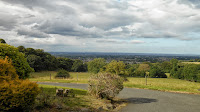"And Ruth the Moabitess said unto Naomi,
Let me now go to the field,
and glean ears of corn after him
In whose sight I shall find grace.
And she said unto her, Go, my daughter."
Ruth 2:2 KJV
 |
| Orlagh |
After we turned off the highway, as we looked around, we spotted this huge building up on the side of the hill and began wondering if it was Orlagh. We turned off the highway and drove up through two housing estates and then drove through the gates and up the long avenue up to the house, which takes you into a different world. And yes, the huge building or house that we had seen up on the side of the hill was Orlagh! In the brochure I picked up it says "The location of Orlagh is one of its great assets." And it's not hard to understand why . . . it's situated on a hundred acres of pasture and woodland in the Dublin hills with an amazing panoramic view of the city of Dublin and the Dublin Bay.
Once
we arrived and parked the van, we got out and as I took a look around I was in awe
of the amazing view laid out before me! Looking straight out I could see Dublin
and looking to my right was Howth, where we had visited Monday night for a walk
around the harbor, the Abby and dinner at the Abbey Tavern.
 |
| View from in front of Orlagh - looking north towards Dublin |
We were warmly greeted by one of the Augustinian Father's at Orlagh. He gave us instructions for using the keypad by the front door, so we could get inside . . . and then we walked inside! It's very plain and nondescript on the outside and the inside wasn't exactly what I expected it to be. The tall ceiling with exposed timbers, beautiful tiled floor and the huge stairway that was before us and at the same time very simple. The Father took us upstairs and showed us the six rooms they had ready for us and then where the shared toilets and showers were. I was on the backside and had a lovely view of the woods.
We left our things in our rooms and then went downstairs to the dining room where the Father had tea and biscuits for us. This was a lovely break after our drive. The Father explained a bit of the history of Orlagh and gave us some directions to help us get to Glendalough, which was on our list to go and see that afternoon.
Before
I go any further, let me give you a quick it of history of Orlagh . . .
The original house in Orlagh was built in 1790 by Lundy Foot. The third owner, Andrew Carew O'Dwyer bought the house in 1835. O'Dwyer was active with Daniel O'Connell in the campaign for Catholic Emancipation and many of the prominent political figures of the nineteenth century were entertained at Orlagh.
The original house in Orlagh was built in 1790 by Lundy Foot. The third owner, Andrew Carew O'Dwyer bought the house in 1835. O'Dwyer was active with Daniel O'Connell in the campaign for Catholic Emancipation and many of the prominent political figures of the nineteenth century were entertained at Orlagh.
The Augustinians bought the house from O'Dwyer's sons in 1872. It served as a novitiate for the Augustinians until 1990, and since 1997 has been used as a retreat centre and a place of welcome for those seeking time apart for personal renewal.
I wish we had had more time at Orlagh . . . time to explore the grounds outside and time to just sit and soak in all that Orlagh has to offer.
I will leave you with this piece that I found this in the front of a brochure that I picked up when I was at Orlagh, I find that in some way it speaks to me . . .
The Spirit of Orlagh
We explore faith in a way that speaks to life
We use scholarship that feeds the search for meaning and truth
We celebrate Liturgy that invites participation
We offer a welcome that is inclusive and give people a space to "be"
We promote a spirituality that brings faith and experience together
We encourage a way of being and doing that promotes fellowship on life's journey








































